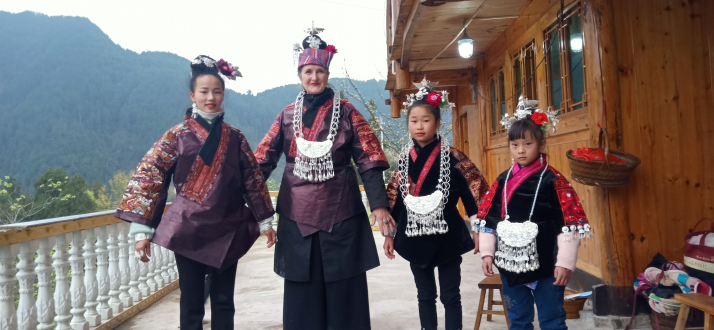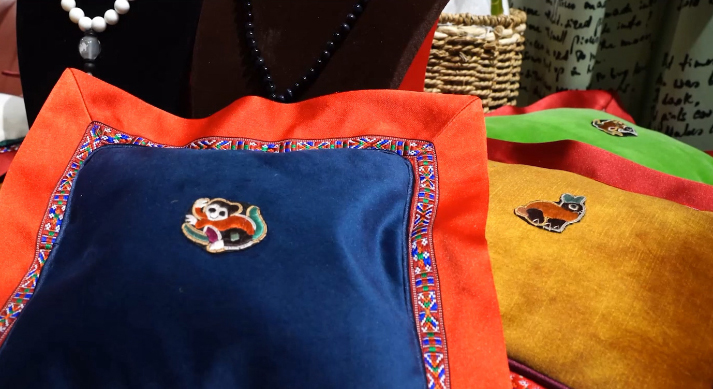A Belgian designer redefines fashion with the help of ethnic embroidery
Walking into the Beijing-based studio of Belgian designer Jehanne de Biolley, one will be immediately drawn to the robes adorned with beautiful handwritten English words. The elegant dresses seem to be entirely Western style, but a closer look will reveal the presence of four Chinese characters: Miao Zu Shi Shi, which translates as "epics of the Miao ethnic group." The theme suggests the garments' Chinese soul.
"When I was around 18, I discovered Asia and I decided to dedicate my life to the study of Asian culture, and then that of Chinese culture," De Biolley told Beijing Review.
She was born into an aristocratic family in Belgium in the 1960s, with a lineage that traces back to medieval France.
De Biolley first got into handicrafts like lacemaking and knitting when she was 5 or 6. At 18, she went on to study art history, then lived in London for more than 12 years, where she owned an Asian art gallery prior to moving to China in 1997. Her background in the arts brought her both professional and personal happiness in China: After settling down in Beijing, she married Liu Linian, a Chinese director and designer, and set up shop in the city.
She has been in China for 30 years. Better known here as Cui Cui, inspired by the Chinese name for kingfisher (cuiniao)—one of her favorite bird families, she has traveled all across the country, including to the southwestern province of Guizhou, Xinjiang Uygur Autonomous Region and Tibet Autonomous Region, the ethnic cultures of which have all inspired her designs.
Her studio is now located in Yongyuan Park, an area focusing on the innovation and development of intangible cultural heritage, in Beijing's Dongcheng District. First opening to the public in 2019, the park was created to allow inheritors of intangible cultural heritages to work with designers to find ways to blend the traditional arts more seamlessly with public life. Two years later, Yongyuan would offer De Biolley a space to develop her Miao embroidery products.
The embroidery of China's Miao minority, an ethnic group mainly residing in the country's southern regions, is a remarkable artistic tradition spanning 2,000 years and involving a myriad of complex stitches that lend it its unique features, which are very different from, for example, traditional Han Chinese embroidery.
Courtesy of De Biolley's unrelenting efforts, the needlework has made its way from Guizhou's remote mountainous areas to Beijing.
"What I find fascinating about Miao embroidery is that it carries the story of their beliefs and life. I want to celebrate that beauty by creating collections so that I bring the past into the future," De Biolley said.

Creating connections
De Biolley unexpectedly started a new creative chapter as an artist in 2021, when she was invited to go to Guizhou for inspiration. "I arrived there and immediately realized there was this incredibly beautiful craftsmanship, including embroidery and handweaving," she said.
The scenes of Miao women creating their typically florid handwoven fabrics on looms and adding a touch of impeccable and meticulous needlework left a deep impression. "They weave by hand without following a pattern. When it's machine-woven, you don't get that same extraordinary beauty," she said. She then decided to start commissioning their works as a token of support. The artisans make as much as 100 yuan ($14.6) per day for their work.
According to De Biolley, the craftsmanship is a prime example of artisanal excellence and beauty and also gives an introduction to the culture and tradition of the Miao people. Every aspect of Miao embroidery bears different meaning. "And the history, the culture, and the beliefs are coded into the weaving," she added.
In her words, the Miao women lead "very distinctive" lives. "They have this community life where they work, weave and embroider together. They have a passion for what they do."
"I speak some Chinese. Although I don't speak the Miao language, I can easily communicate with local people because we have the same sensitivity when it comes to colors, materials and designs. The Miao women were very welcoming and interested in teaching me," she explained.
Among De Biolley's designs integrating traditional Miao handcraft are some beautiful robes featuring the minority's legends translated into English. "I often ask locals questions and they always say, 'you can read our epics to find the answers to all your questions'," she said. But this was easier said than done. As the Miao people do not have a written language, the epics were traditionally passed down in oral form. Luckily, to help preserve the cultural heritage, several of Guizhou's cultural museums had already transliterated the Miao words into Chinese characters. De Biolley then combed through the tales and extracted some passages she thought were of great interest.
One example of this undertaking's result is her understanding of the symbolism on a dress with dots on the collars and embroidery depicting the sun and moon on the back. "The dots represent eggs. The Miao believe the legendary Mother Butterfly once laid 12 eggs, one of which was the distant ancestor of the Miao people. The sun and the moon are also typical motifs in Miao embroidery, representing the cycle of life and nature," she explained.
The sun and moon aside, plants and butterflies are also common elements. And De Biolley believes that the motifs can connect people, especially those residing in urban landscapes, more to nature.
The Miao embroiderers are open to her designs, but on occasion do insist she keep in some of the elements that may seem trivial to an outsider but in fact carry far deeper meanings. For example, when De Biolley asked them if she could use the head cloth many women don to design pants, the artisans took no issue. But when the Belgian artist asked whether she could take out some of the yellow parts seen on the cloth, the Miao women told her these parts symbolize how they used to cross rivers, and so should be kept in.
Miao people living in Guizhou's mountains often had to cross many rivers when making their way across and out of the region. The province only commenced the construction of quality paved roads that provide quick connections between its villages and cities roughly one decade ago.

Customizing customs
As entertainment on smartphones and computers prevails among the younger generations of today, carrying forward traditional craftsmanship in modern times is getting harder. This also goes for the Miao minority.
"Embroidery and handweaving are both time-consuming and difficult. Traditionally, children would start to learn the craftsmanship at a young age. If the artisans make enough money with their embroidery while staying near their family, they will teach their children how to do it. Embroidery is an important channel for local women to become financially independent," she added.
As more Chinese consumers have embraced their national heritage in recent years, De Biolley hopes to promote contemporary clothing incorporating Miao needlework among younger generations nationwide. Angel Wang, a Chinese model in her 20s, is a friend of De Biolley's and wore one of her designs at a fashion show. "I feel this kind of Miao-style suit fits me. I can wear my boots with the outfit. I love this cool style," Wang told Beijing Review.
"That's a good sign. If young and elegant people like Wang want to go out in such dresses, it means we are sharing the story. I will continue to use my platform to deliver the Miao knowhow, beauty and lifestyle and share it everywhere," De Biolley concluded.

